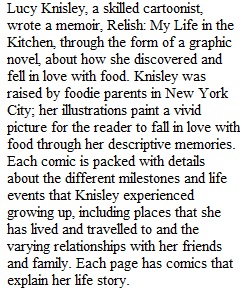


Q Short Paper 3: On Lucy Knisley’s Relish; or, Reading Comic Book Art Purpose First, let’s review the learning outcomes of the class: Demonstrate an understanding of the consequences of human actions in social and environmental contexts, and an ability to consider the ethical and practical implications of those actions Demonstrate an ability to recognize the importance of creative human expression Demonstrate an ability to recognize and respect the rights of the individual and to appreciate the complexity and variety of divergent attitudes, values and beliefs in society Demonstrate an understanding of the cultural and historical heritage of contemporary society and the implications of this heritage This paper seeks to help you make progress towards these goals by taking the once-dismissed art form of the comic as serious art that, like other art, attempts to confront, engage, or otherwise understand the world. In recent years the graphic novel, the graphic memoir, and the graphic autobiography have injected new importance into comic art, especially as artists have used the form to address serious issues (think, for example, about the massive popularity of Persepolis, the English-language edition of which was published in 2003-2004, and Fun Home, which was published in 2006). Of course, many of you are probably familiar with the works of Alan Moore (The League of Extraordinary Gentlemen, Watchmen, V for Vendetta, Lost Girls) and Neil Gaiman (American Gods, The Sandman), who are popular in no small part because of screen adaptations of their works. Thus, we are firmly dealing with outcome two in the list. Knisley also helps us understand human difference and individuality and what that looks like when we make food decisions. Knisley’s memoir also helps us put food into a specific historical context and to understand how the world we live in now comes out of that moment. And even if Knisley’s environmental and social politics aren’t transparent, she does allow us to consider the consequences of our actions and the “ethical and practical implications of those actions.” Assignment Write a 750-word analysis of one frame from Lucy Knisley’s graphic memoir Relish. Analyze the frame by using one of the text-image interactions described by Scott McCloud in the excerpt we read from Understanding Comics. At the very least, you should answer the following questions (and of course they should be answered within the flow of an essay that fulfills the writing standards of an upper-division humanities course): Which word-picture relationship are you using? According to McCloud, how does this word-picture relationship work to move a story along or add meaning that words or images alone could not or would not achieve? What does this word-picture dynamic achieve in Knisley? What’s significant about her decision to use this particular word-picture relationship at this point in her story and/or to depict this moment? That is, how do the words and pictures fit the content? Note: You should provide a clear explanation of the McCloud word-picture dynamic you will use. You should also give a thorough description of the Knisley frame you’ve chosen to work with. You can’t assume your reader is familiar with either, and they should be able to clearly understand both. Tips As I’ve mentioned before, the essays and discussion posts in this class should be regarded as pumped-up versions of ENG 102 writing. I grade based on the same standards: claim, support, development, analysis, engaging prose, MLA style, and grammar and usage. I’m not pulling a fast one on you, I promise. So what does this mean? It means that everything you write should have an introduction, body, and conclusion. The introduction should introduce the topic and narrow down to the point you want to make about the topic (thesis). Each paragraph in the body should establish a different main point that develops, supports, illustrates, or otherwise elaborates on the thesis. Your conclusion should wrap things up and explain why your thesis (your unique perspective on the topic/text) matters. If it helps, you might think of body paragraphs as each performing what I refer to as an “analysis sandwich.” Each body paragraph should 1) Make a claim with the topic sentence 2) Add some information that puts your evidence in context 3) Support that claim with evidence (usually a quote or some other textual element from the text you are writing about but sometimes evidence from research) 4) Explain how that evidence supports the topic sentence. That is, if you “feel” or “think” that a frame is doing something, you need to explain what caused that feeling or made you think that. 5) You need to wrap up the paragraph by making it clear how the paragraph has supported your thesis. For more on the analysis sandwich, see my brief lecture called, you guessed it, “Analysis Sandwich.” Criteria for Evaluation You have a clear thesis statement, and it makes an arguable and significant claim You support that claim with specific evidence from the two texts You analyze the evidence to demonstrate how it supports the claim (i.e., you are reproducing your way of understanding/reading the frame) You make it clear which of McCloud’s word-picture relationships you are working with, and you explain it in your own words You provide a clear and thorough description of the Knisley frame you have chosen to work with—clearly enough that someone without access to the book would be able to “see” it Your essay is 750 words You use MLA formatting and citations—and use them properly. That means you have a heading, title, in-text citations, and a Works Cited page You use varied language and sentence structures to produce lively and interesting prose You write at a college level: language, grammar, sentence structure, etc. This also includes basics such as properly inserting author names and the titles of the texts you are using Your writing is free of common composition errors, especially run-on sentences and fragments
View Related Questions